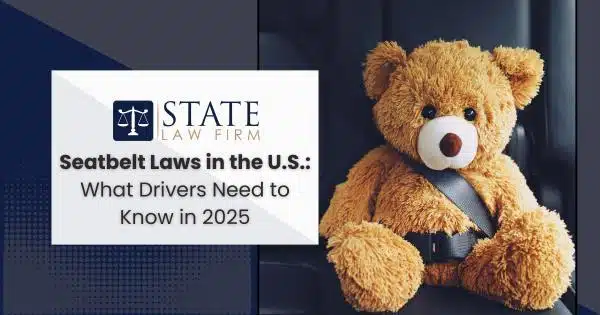Seatbelts are one of the most effective tools for protecting drivers and passengers on the road, yet millions of Americans still choose not to use them. According to the National Highway Traffic Safety Administration, seatbelt use saved nearly 15,000 lives in a single year—a staggering testament to the life-saving power of seatbelts. Source.
As we head into 2025, seatbelt laws across the United States continue to evolve, reflecting new research, advances in vehicle safety technology, and a growing commitment to reducing preventable injuries. For drivers, staying informed about these regulations isn’t just about compliance—it’s about safeguarding yourself and those you care about from the devastating impact of severe collisions.
At State Law Firm, our team of dedicated personal injury attorneys is passionate about helping clients navigate the aftermath of motor vehicle accidents, including those involving catastrophic injuries such as traumatic brain damage. If you or someone you love has been hurt because of another driver’s negligence, our Sherman Oaks car accident lawyers are here to guide you every step of the way.
This guide will walk you through everything you need to know about current seatbelt laws in the U.S., the latest updates expected in 2025, and common myths that could put you at risk. We’ll also share practical tips and resources to help you stay informed and compliant, enabling you to drive with greater confidence. Suppose you’re interested in understanding the long-term effects of serious injuries often linked to unrestrained accidents. In that case, you can also explore our article on the long-term effects of traumatic brain injury.
Let’s start by taking a closer look at why seatbelt laws matter now more than ever.
A Comprehensive Overview of Current Seatbelt Laws by State
Seatbelt laws differ dramatically depending on where you drive. While all 50 states and the District of Columbia require seatbelts in some form, enforcement and penalties vary widely.
- Primary enforcement laws allow law enforcement officers to stop and ticket a driver solely for not wearing a seatbelt.
- Secondary enforcement laws mean officers can only issue a seatbelt citation if the driver has been pulled over for another reason, such as speeding or a broken taillight.
For example:
- California requires all occupants eight years and older to use seatbelts, with primary enforcement in all seating positions. Fines start at $162 for adults and can be significantly higher if minors are unbelted.
- Arizona has secondary enforcement for adults in front seats, though child restraint violations are primary offenses.
- New Hampshire remains the only state without an adult seatbelt law (though child restraints are still mandatory).
Many states also impose escalating penalties for repeat violations and assign points to your driving record, which can increase insurance rates.
Key considerations when traveling between states:
- Age and weight thresholds for booster seats can differ
- Fines and court fees vary significantly.
- Law enforcement discretion in issuing citations can vary significantly from one jurisdiction to another.
Pro Tip: If you frequently drive in multiple states, keep a printed quick-reference chart in your glovebox or save your insurance carrier’s state law resource on your phone. This can help avoid costly misunderstandings during road trips.
If you ever find yourself involved in a collision, our Sherman Oaks car accident attorneys can explain how seatbelt compliance might affect liability and compensation.
The Latest Updates and Changes to Seatbelt Legislation Expected in 2025
With rising public awareness and data-driven policymaking, many states are revising their seatbelt laws. Some of the most notable trends expected in 2025 include:
- Rear-seat enforcement: Legislatures in Illinois, Maryland, and Nevada are moving toward primary enforcement for all passengers, not just front-seat occupants.
- Graduated penalty structures: Fines will increase for repeat offenders, in some cases tripling for a second or third violation.
- Integration of new technologies: States like California and New York are exploring digital enforcement methods, including in-vehicle sensors that can automatically report non-use to insurance carriers (though privacy concerns remain).
- Enhanced public education: Expanded funding for community campaigns targeting rural areas, where seatbelt use rates are often lowest.
Additional anticipated initiatives:
- Incentive programs offering insurance discounts to policyholders who participate in seatbelt compliance monitoring
- Stronger child safety seat requirements, especially for rideshare vehicles and taxis
Understanding these trends can help you avoid fines, protect your passengers, and ensure that your insurance coverage stays intact.
For drivers concerned about potential liability in an accident, our article on the long-term effects of traumatic brain injury explores why consistent seatbelt use can be a crucial factor in reducing the severity of injury claims.
The Impact of Seatbelt Use on Road Safety and Accident Statistics
Seatbelts have saved more lives than nearly any other vehicle safety innovation. According to the CDC, seatbelts reduce the risk of death by 45% and serious injury by 50% for drivers and front-seat passengers.
Consider these vital statistics:
- In 2022, nearly 51% of passenger vehicle occupants killed in crashes were unrestrained.
- Ejection from a vehicle is one of the most deadly outcomes of a crash, and seatbelts prevent complete ejection in 99% of cases.
- Proper restraint use for children in car seats lowers the risk of fatal injury by 71% for infants and 54% for toddlers.
In addition to saving lives, seatbelts also have significant economic impacts:
- Motor vehicle crashes cost the U.S. more than $75 billion annually in medical care and lost productivity.
- Universal seatbelt use could save taxpayers and insurers billions in preventable healthcare costs.
Pro Tip: Take a few seconds to double-check that every passenger in your vehicle—especially in the back seat—is properly secured before you drive. This is not just about compliance but about setting a culture of safety in your household.
Common Myths About Seatbelts: Debunking Misconceptions for Safer Driving
Even in 2025, many persistent myths continue to pose a risk to drivers. Here are a few of the most widespread—and dangerous—misunderstandings:
- Myth: “If I’m a good driver, I don’t need a seatbelt.”
Fact: You cannot control the actions of other drivers or unpredictable events like tire blowouts, weather conditions, or mechanical failures. - Myth: “Seatbelts will trap me in a fire or underwater.”
Fact: Crashes involving fire or submersion account for less than 0.5% of accidents. In most cases, a seatbelt will keep you conscious and able to escape. - Myth: “I’m safer in the back seat without a belt.”
Fact: Unbelted rear passengers are 3 times more likely to be killed and can become projectiles, seriously injuring front-seat occupants.
Educating yourself and others about these facts can help create safer roads for everyone.
Pro Tip: Share this section with teenage drivers and older adults in your family. These groups are statistically less likely to buckle up and more likely to believe outdated myths.
How to Stay Informed and Compliant with Changing Seatbelt Laws
Because regulations change frequently, it’s smart to develop habits for staying informed. Here are some practical strategies:
- Subscribe to your state’s Department of Transportation email alerts and newsletters
- Follow reputable safety organizations, such as the National Highway Traffic Safety Administration and your state’s Office of Traffic Safety.
- Review your auto insurance policy each renewal period to determine if any premium incentives are available for documented seatbelt use.e
- Participate in community workshops or safety demonstrations, which often offer resources and free car seat checks.
If you’re involved in a collision where seatbelt use is questioned, having a clear understanding of the law can strengthen your case. Our team at State Law Firm is here to help you navigate the legal process with confidence, ensuring you have experienced advocates on your side if a serious injury claim arises.


